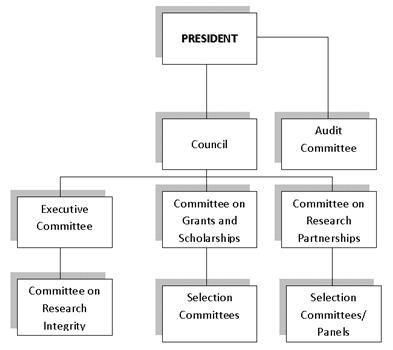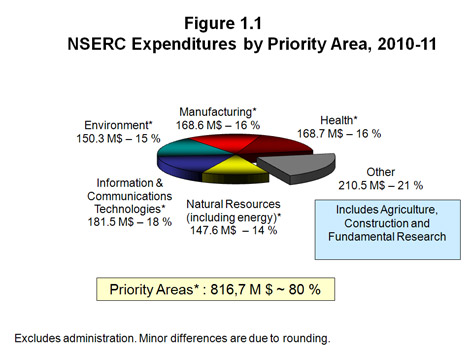Common menu bar links
Breadcrumb Trail
ARCHIVED - Natural Sciences and Engineering Research Council of Canada - Report
 This page has been archived.
This page has been archived.
Archived Content
Information identified as archived on the Web is for reference, research or recordkeeping purposes. It has not been altered or updated after the date of archiving. Web pages that are archived on the Web are not subject to the Government of Canada Web Standards. As per the Communications Policy of the Government of Canada, you can request alternate formats on the "Contact Us" page.
Minister's Message

Over the past year, the Canadian economy has proven to be resilient despite continued fiscal uncertainty in other parts of the world. Since our government introduced Canada's Economic Action Plan in 2009 to respond to the global recession, Canada has recovered not only all of the jobs lost during the recession but also all of our economic output.
As Minister of Industry, I am confident that the Industry Portfolio will play a key role in our government's plan to strengthen Canada's knowledge-based economy. Our efforts will focus on promoting innovation and modernizing Canada's marketplace policies, among other areas.
In 2012–13, the Natural Sciences and Engineering Research Council of Canada (NSERC) will create new opportunities for Canadian scientists and engineers to become global research leaders. It will also enhance its promotion of international research collaborations. NSERC will further support the increasing engagement of colleges and universities in Canada's innovation system and will build a competitive advantage for Canada by creating more strategic partnerships with the private sector and training more graduates in the skills needed for tomorrow's economy.
A significant part of the Industry Portfolio's activities will involve developing Canada's digital economy by updating copyright and privacy laws and building a world-class digital infrastructure for next-generation wireless technologies and services. We will also put in place conditions that allow small businesses to grow and create jobs. This will mean reducing red tape, improving access to credit and focusing programs to promote more effective research and development.
Since coming to office, our government has made science and innovation a priority. We will leverage our past investments and continue to develop and recruit world-leading research talent. We will also take measures to encourage the private sector to increase research and development investments and improve commercialization outcomes.
In our government's pursuit to improve the well-being of Canadians, we will continue to work to secure the recovery, eliminate the deficit and invest in the drivers of long-term economic growth. We will also implement our plan to find savings in government expenditures to return to fiscal balance in the medium term.
This year's Report on Plans and Priorities for NSERC delivers a comprehensive approach to promote and maintain Canada's strong and competitive economy. I look forward to working with my Cabinet and departmental colleagues, as well as with the private sector and other levels of government, to achieve our common goal of creating jobs and growth for all Canadians.
The Honourable Christian Paradis
Minister of Industry and Minister of State (Agriculture)
Minister of State's Message

As the Minister of State for Science and Technology, I am pleased to present the 2012–13 Report on Plans and Priorities for the Natural Sciences and Engineering Research Council of Canada (NSERC).
This year promises to be noteworthy, not only for Canada but also for the world. As economies across the globe begin to emerge from challenging economic times, Canada continues to thrive. Our financial system is strong, our economy has recovered all of the jobs and economic output lost during the recession, and our government has a low-tax plan that will continue to create jobs, economic growth and long-term prosperity across the country.
Our government recognizes the vital role that science and technology play in Canada’s continued economic leadership. In this globalized and connected digital world, innovation will be the driver of economic growth. We understand this, and we are committed to supporting Canadian research and development (R&D) in both public and private sectors.
This year will see our government take specific actions to improve Canada’s performance with respect to private sector R&D, following last year’s report from the expert panel charged with the review of federal support for R&D. These actions will build on our investments to date and will seek to promote commercialization and the development of new products and services for Canadians.
In 2012–13, NSERC will maintain its support for academia-industry collaborations that foster more diversity in the Canadian economy. This year, NSERC will hold a national competition to support atmospheric and climate change research in Canada. Through a number of similar programs and grants, NSERC will support R&D at the regional and community levels across the country while continuing to provide Canadian scientists and engineers with the necessary support that enables them to push the boundaries of modern scientific research. NSERC remains committed to ensuring Canada’s place in the global scientific community.
Canadians can and should be proud. Our government recognizes that we cannot take our success for granted. We must build on our past accomplishments in order to continue to grow, create jobs and lead the world for years to come. We are committed to achieving this, and it will be driven in no small part by science, research and innovation.
As we move into 2012–13, I will continue to work with our academic partners, the private sector and all Canadians to achieve the priorities laid out in this report.
The Honourable Gary Goodyear
Minister of State (Science and Technology) (Federal Economic Development Agency for Southern Ontario)
Section I: Organizational Overview
Raison d'être
The Natural Sciences and Engineering Research Council of Canada (NSERC) is a leader in making Canada a country of discoverers and innovators for all Canadians. NSERC aims to maximize the value of public investments in research and development (R&D) and to advance prosperity and quality of life in Canada. In today’s highly competitive knowledge economies, NSERC plays a key role in Canada’s innovation system. NSERC offers programs that support postsecondary research in the natural sciences and engineering (NSE) on the basis of national, peer-reviewed competitions. NSERC supports partnerships and innovation to make it easier for industry to collaborate with academia and access the wealth of resources Canada’s first-rate academic system has to offer. NSERC develops the next generation of talented scientists and engineers through its scholarships and research stipends, and increases the visibility of Canadian research.
NSERC Quick Facts
President: Dr. Suzanne Fortier
Chair: The Honourable James Edwards
Budget: $1.07 billion (2011-12)
Head Office: Ottawa, Ont.
Regional Offices:
- Moncton, N.B.
- Montréal, Que.
- Winnipeg, Man.
- Vancouver, B.C.
- Mississauga, Ont.
Employees: 376 Full-time Equivalents (FTEs)
Reach:
- 29,200 students and postdoctoral fellows
- 11,800 university professors
- 1,913 Canadian companies
- over 140 universities and colleges
Responsibilities
NSERC is a departmental corporation of the Government of Canada created in 1978. It is funded directly by Parliament and reports to it through the Minister of Industry. NSERC’s Council is composed of the President and up to 18 other distinguished members selected from the private and public sectors. The elected Vice-President is the Chair of Council and of its Executive Committee. The Council is advised on policy matters by various standing committees. The President of NSERC is the Chief Executive Officer. Funding decisions are approved by the President on the basis of recommendations made by peer review committees.
In fiscal year 2012-13, NSERC will invest over $1 billion in postsecondary research and training in the NSE. NSERC’s budget represents ten percent of the federal government’s expenditures for science and technology (S&T), and twenty percent of all university R&D funding in the NSE.
The functions of NSERC, based on the authority and responsibility assigned to it under the Natural Sciences and Engineering Research Council Act (1976-1977, c.24), are to:
- promote and assist research in the natural sciences and engineering, other than the health sciences; and
- advise the Minister in respect of such matters relating to such research as the Minister may refer to the Council for its consideration
NSERC’s Governance Structure

Text description of this image
NSERC’s focus on people, discovery and innovation maps directly onto the federal science and technology (S&T) strategy which emphasizes building a People Advantage, a Knowledge Advantage and an Entrepreneurial Advantage for Canada. All of NSERC’s funding relates to these advantages. In addition, the majority of NSERC’s expenditures are in areas that fall under the S&T priorities established by the government. The following figure highlights NSERC’s priority area expenditures in 2010-11.

Text description of this image
Strategic Outcome(s) and Program Activity Architecture
In order to achieve its mandate, NSERC works toward the following strategic outcomes:
- People: Highly skilled science and engineering professionals in Canada
- Discovery: High-quality Canadian-based competitive research in the natural sciences and engineering
- Innovation: Knowledge and skills in the natural sciences and engineering are transferred to, and used productively by, the user sector in Canada
Program Activity Architecture
| 1.0 People Highly skilled science and engineering professionals in Canada |
2.0 Discovery High quality Canadian-based competitive research in the natural sciences and engineering |
3.0 Innovation Knowledge and skills in the natural sciences and engineering are transferred to and used productively by the user sector in Canada |
|---|---|---|
| Promote Science and Engineering | Fund Basic Research | Fund Research in Strategic Areas |
| Sub-Activities | Sub-Activities | Sub-Activities |
|
|
|
| Support Students and Fellows | Support for Research Equipment and Major Resources | Fund University-Industry-Government Partnerships |
| Sub-Activities | Sub-Activities | Sub-Activities |
|
||
| Attract and Retain Faculty | Support Commercialization | |
| Sub-Activities | Sub-Activities | |
| Internal Services |
|---|
Sub-Activities
|
Organizational Priorities
| Priority | Type | Strategic Outcome |
|---|---|---|
| People Advantage | Ongoing | 1.0 People |
| Description: Inspire new generations of students to pursue careers in science and engineering, and provide them with the means to develop their full potential. | ||
|
Why is this a priority?
Plans for meeting the priority:
|
||
| Priority | Type | Strategic Outcomes |
|---|---|---|
| Knowledge Advantage | Ongoing | 1.0 People 2.0 Discovery |
| Description: Lead the advancement of knowledge in science and engineering, and ensure that Canadian scientists and engineers are leaders and key players in a global knowledge community. | ||
|
Why is this a priority?
Plans for meeting the priority:
|
||
| Priority | Type | Strategic Outcome |
|---|---|---|
| Entrepreneurial Advantage | Ongoing | 3.0 Innovation |
| Description: Connect and apply the strength of the academic research system to addressing the opportunities and challenges of building prosperity for Canada. | ||
|
Why is this a priority?
Plans for meeting the priority:
|
||
| Priority | Type | Strategic Outcomes |
|---|---|---|
| Accountability | Ongoing |
1.0 People |
| Description: Demonstrate NSERC's accountability and how the results of its investments in Canadian research and training benefit Canadians. | ||
|
Why is this a priority?
Plans for meeting the priority:
|
||
| Priority | Type | Strategic Outcomes |
|---|---|---|
| Visibility | Ongoing | 1.0 People 2.0 Discovery 3.0 Innovation |
| Description: Increase visibility of Canadian research. | ||
|
Why is this a priority?
Plans for meeting the priority
|
||
Risk Analysis
NSERC’s strategic and operational priorities are managed and monitored according to NSERC’s Corporate Risk Profile which is updated annually.
In alignment with Treasury Board Secretariat guidelines and management frameworks, NSERC developed its Corporate Risk Profile in 2011-12 to formally identify, assess and mitigate corporate risks. A number of risks were identified and mitigation strategies were developed. The two risks which may impact NSERC’s plans and priorities over the reporting period are summarized below:
| Risk | Mitigation |
|---|---|
| Information Technology Innovation: The risk that the organization does not adequately leverage technology to support the needs of the organization, to promote efficiency or to innovate (i.e. services and processes). | The IMIT Strategy that was introduced at NSERC in 2011-12 will serve to proactively lever technology to improve the efficiency of internal operations and client service. |
| Budget Management: The risk that the organization is ineffective in managing, controlling and monitoring budgets and making informed/accurate resource-related decisions. | Implementation of a modernized corporate resource management framework and integrated planning at NSERC mitigate against this risk. |
Operating Environment
While NSERC administers a significant budget, the Council’s overall risk level compared to other government entities is considered low, in terms of continuity of government operations and the maintenance of services to, and protection of the interests of, the Canadian public.
Operational Risks
The risks that were identified are reflective of current economic times of fiscal constraint which require innovative approaches and new technologies to improve efficiency within organizations.
NSERC experiences risks related to the current economic situation that are integral to all of its programs and that could influence plans, priorities, performance and decision making over the three-year reporting period.
Planning Summary
Financial Resources ($ millions)
| 2012-13 | 2013-14 | 2014-15 |
|---|---|---|
| 1,049.6 | 1,036.6 | 1,036.6 |
Human Resources (Full-Time Equivalent - FTE)
| 2012-13 | 2013-14 | 2014-15 |
|---|---|---|
| 388 | 388 | 388 |
| Performance Indicators | Targets |
|---|---|
| Total researchers per thousand employed relative to other OECD countries | Maintain top 10 world ranking (Canada was 8th in 20053) |
| Employment rate of university graduates in the NSE vs. general population | NSE unemployment rate less than rate for general population by at least 1 percentage point |
| Program Activity | Forecast Spending 2011-12 |
Planned Spending | Alignment to Government of Canada Outcomes4 | ||
|---|---|---|---|---|---|
| 2012-13 | 2013-14 | 2014-15 | |||
| 1.1 Promote Science and Engineering | 5.5 | 5.8 | 5.8 | 5.8 | Innovative and Knowledge-based Economy |
| 1.2 Support Students and Fellows | 149.8 | 141.8 | 141.8 | 141.8 | |
| 1.3 Attract and Retain Faculty | 152.6 | 153.0 | 153.0 | 153.0 | |
| Total Planned Spending | 300.6 | 300.6 | 300.6 | ||
| Performance Indicators | Targets |
|---|---|
| Average number of times that Canadian papers in the NSE are cited by other researchers (Average Relative Citation factor of Canadian publications in the NSE ― comparison with other countries) | Maintain top 20 world ranking (Canada was 16th in 20085) |
| Per capita output of publications in the NSE. | Top 10 ranking in the world6 |
| Program Activity | Forecast Spending 2011-12 |
Planned Spending | Alignment to Government of Canada Outcomes | ||
|---|---|---|---|---|---|
| 2012-13 | 2013-14 | 2014-15 | |||
| 2.1 Fund Basic Research | 363.4 | 366.6 | 368.0 | 368.0 | Innovative and Knowledge-based Economy |
| 2.2 Support for Research Equipment and Major Resources | 38.0 | 37.1 | 23.0 | 23.0 | |
| Total Planned Spending | 403.7 | 391.0 | 391.0 | ||
| Performance Indicators | Targets |
|---|---|
| Percentage growth in the annual number of partner companies | Greater than five percent per year |
| Comparison of percentage of HERD funded by industry to OECD countries | Top quartile ranking |
| Program Activity | Forecast Spending 2011-12 |
Planned Spending | Alignment to Government of Canada Outcomes | ||
|---|---|---|---|---|---|
| 2012-13 | 2013-14 | 2014-15 | |||
| 3.1 Fund Research in Strategic Areas | 116.4 | 106.6 | 95.8 | 85.5 | Innovative and Knowledge-based Economy |
| 3.2 Fund University-Industry-Government Partnerships | 179.0 | 171.8 | 181.0 | 191.5 | |
| 3.3 Support Commercialization | 58.6 | 42.9 | 44.1 | 43.9 | |
| Total Planned Spending | 321.3 | 320.9 | 320.9 | ||
| Program Activity | Forecast Spending 2011-12 |
Planned Spending | ||
|---|---|---|---|---|
| 2012-13 | 2013-14 | 2014-15 | ||
| Internal Services7 | 25.8 | 24.0 | 24.1 | 24.1 |
| Total Planned Spending | 24.0 | 24.1 | 24.1 | |
Expenditure Profile
Departmental Spending Trend
For the 2012-13 fiscal year, NSERC plans to spend 1,049.6 $ million to meet the expected results of its program activities and contribute to its strategic outcomes. The figure below illustrates NSERC's spending trend from 2009-10 to 2014-15.

Spending increase:
From 2009-10 to 2011-12, the following new investments were made:
- $2.5 million in 2009-10 and $1 million in 2010-11, for the Industrial R&D Internships (IRDI) program as part of Canada’s Economic Action Plan (Budget 2009);
- $14 million in 2009-10, $14 million in 2010-11, and $7 million in 2011-12 for a temporary expansion of the Canada Graduate Scholarships (CGS) program as part of Canada’s Economic Action Plan (Budget 2009);
- $13 million per year in 2010-11 for advanced research and for the Strategy for Partnerships and Innovation (Budget 2010);
- $15 million per year to the College and Community Innovation Program to increase innovation at the community and/or regional level (Budget 2010);
- $45 million over five years to all three granting councils to establish the Banting post-doctoral fellowships program (Budget 2010);
- $35 million over five years to support climate change and atmospheric research at Canadian post-secondary institutions (Budget 2011);
- $3 million in 2011-12 and $5 million per year on a permanent basis starting in 2012-13 to support 30 new Industrial Research Chairs at colleges (Budget 2011);
- $15 million per year to support outstanding research in the naturals sciences and engineering fields, such as the Strategy for Partnerships and Innovation;
- $12 million over five years, starting in 2011-12 to support college-university collaboration through the Idea to Innovation program (Budget 2011);
- $53.5 million over five years to support the creation of 10 new Canada Excellence Research Chairs, some of which will be in fields relevant to the digital economy (Budget 2011);
- $15 million over five years for a competition to select a Canada-India Research Centre of Excellence (Budget 2011).
Spending decrease:
- Over the period covered by this report, decreases resulted from the following:
- The funding for the BL-NCE program is scheduled to sunset in 2012-13. The program supported four industry-led networks over five years with a total budget of $46 million earmarked in Budget 2007 and administered by NSERC.
- The last portion of the $38.5 million received by NSERC as part of Canada’s Economic Action Plan for additional Canada Graduate Scholarships and Industrial Research and Development Internship awards will be spent in 2011-12.
Estimates by Vote
For information on our organizational appropriations, please see the 2012-13 Main Estimates publication.
